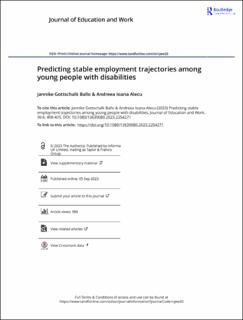| dc.contributor.author | Ballo, Jannike Gottschalk | |
| dc.contributor.author | Alecu, Andreea Ioana | |
| dc.date.accessioned | 2023-11-23T07:22:55Z | |
| dc.date.available | 2023-11-23T07:22:55Z | |
| dc.date.created | 2023-09-20T10:33:36Z | |
| dc.date.issued | 2023 | |
| dc.identifier.citation | Journal of Education and Work. 2023, 36 (6), 408-425. | en_US |
| dc.identifier.issn | 1363-9080 | |
| dc.identifier.uri | https://hdl.handle.net/11250/3104210 | |
| dc.description.abstract | Research aiming to explain disabled people’s inequalities in the labour
market has primarily focused on transitional factors between school and
work, wage gaps, or socioeconomic background characteristics as expla-
nations for (no-)entry in the labour market. There is a lack of longitudinal
studies that map how disabled people fare in the labour market over time.
Therefore, the objective of this paper is to identify, describe and predict
stable employment paths of long-term disabled people. Our study
employs detailed longitudinal data with total coverage of the
Norwegian population – we focus on 11 birth cohorts (1973–83) of
disabled individuals and we follow their employment trajectories between
the ages 20 and 34. To describe employment trajectories and create
a typology of longitudinal labour market attachments, we employ
sequence analysis and subsequently linear probability models to analyse
the association between the disability’s severity, gender, educational
enrolment, early-work experience and employment trajectories. We iden-
tify four main types of trajectories: permanently work-disabled, stable
employment, early marginalisation, and unstable employment. Our find-
ings indicate that men are more likely than women to have stable employ-
ment trajectories. Starting higher education, as well as parental higher
education, is linked with the likelihood of stable employment. | en_US |
| dc.language.iso | eng | en_US |
| dc.rights | Navngivelse 4.0 Internasjonal | * |
| dc.rights.uri | http://creativecommons.org/licenses/by/4.0/deed.no | * |
| dc.title | Predicting stable employment trajectories among young people with disabilities | en_US |
| dc.type | Peer reviewed | en_US |
| dc.type | Journal article | en_US |
| dc.description.version | publishedVersion | en_US |
| cristin.ispublished | true | |
| cristin.fulltext | original | |
| cristin.qualitycode | 2 | |
| dc.identifier.doi | 10.1080/13639080.2023.2254271 | |
| dc.identifier.cristin | 2176896 | |
| dc.source.journal | Journal of Education and Work | en_US |
| dc.source.volume | 36 | en_US |
| dc.source.issue | 6 | en_US |
| dc.source.pagenumber | 408-425 | en_US |

